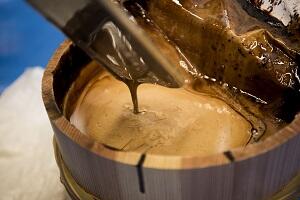Joboji Urushi
| Registration Number | 73 |
|---|---|
| Name of the GI | Joboji Urushi |
| Class | Others |
| Date of Protection | 2018/12/27 |
| Producing Area |
Iwate Prefecture
,
Aomori Prefecture
,
Akita Prefecture
Throughout Iwate Prefecture; Sannohe County, Hachinohe City, and Towada City, Aomori Prefecture; and Kosaka Town in Kazuno County, Kazuno City, and Odate City, Akita Prefecture |
| Applicant - Name and Address | Iwate Prefecture Joboji Urushi Production Association 37-4 Shimomaeda, Joboji-machi, Ninohe City, Iwate Prefecture |
Producing Area
Joboji Urushi is a type of lacquer (1) that provides stable quality with superior hardness once cured.
Joboji Urushi has superior durability, in addition to its wide variations in terms of properties such as transparency, curing time and viscosity, so that it is highly recognized by lacquer artists, lacquer coating artisans, and craftsmen who restore cultural properties.
As an indispensable material in Japanese culture and history, Joboji Urushi has traditionally been used widely for repairing and restoring historic architectures that represent Japan, including national treasures and important cultural properties.
Joboji Urushi is harvested in the above listed areas of production by urushi kaki shokunin, or lacquer tappers, who make their living primarily by harvesting lacquer sap.
The shipment standards for Joboji Urushi require that the lacquer is "not intentionally mixed with foreign material for purposes such as bulking out" and that it is "not mixed with lacquer other than Joboji Urushi." Lacquer that meets these standards is shipped as arami-urushi (extracted lacquer sap) (2) and ki-urushi (raw lacquer) (3).
The producing areas of Joboji Urushi have a long history of seeking to establish the optimum conditions for growing lacquer trees, ever since Morioka Domain (4) first encouraged the cultivation of lacquer trees in the Edo period (5).
In the Meiji era (6), producers began to adopt the new technique of regenerating the lacquer forests by managing the sprouts after the trees are cut down. They have since continued to protect the lacquer forests that produce Joboji Urushi and to pass down the largest lacquer resource in the country until today.
As of 2015, Iwate Prefecture accounts for 278 ha, corresponding to approximately 85%, of the total domestic area under lacquer cultivation of 326 ha.
Today, the Iwate Prefecture Joboji Urushi Producers' Association leads the unified efforts by all stakeholders including the local government and lacquer producers to plant and grow lacquer trees as well as to hand down the techniques of lacquer tapping (7). The area has about 20 artisans who have mastered the traditional techniques and are dedicated to lacquer tapping. These artisans produce wide variations of lacquer that reflect their individual characteristics and techniques.
The area produces 70% of all the Japanese lacquer distributed in the domestic markets as of 2015 by being inherited the superior lacquer tapping techniques and lacquer forests.
- Lacquer: Coating material based on natural resin, used to finish wood products. Wood ware with lacquer coating is referred to as shikki (lacquerware) in Japan. Lacquer has been widely used in ancient crafts and as adhesives. Lacquers used in Japan are made from the sap of poison oak (Toxicodendron spp.), whereas lacquers in Thailand and Myanmar are produced by processing the sap of Burmese lacquer (Gluta usitata).
- Arami-urushi: Lacquer sap taken from the lacquer tree.
- Ki-urushi: Unrefined, raw lacquer made by removing some impurities from arami-urushi.
- Morioka Domain: A feudal domain (han) ruled under the centralized feudalism in the Edo period. It was located in northern Mutsu Province (Mutsu no Kuni) corresponding to the north central region of present-day Iwate Prefecture and the eastern part of present-day Aomori Prefecture, which was ruled by the Nanbu clan, the domain lord (hanshu) who had been given the area as its domain. A total of nearly 250 domains existed throughout Japan at the time, which governed respective local areas under a system of centralized feudalism with the Tokugawa Shogunate at the top.
- Edo period: An era of Japanese history extending from 1603 to 1867, under the shogunate established in Edo (present-day Tokyo). With Ieyasu Tokugawa as the first shogun, the Tokugawa family ruled the country thereafter under the centralized feudalism.
- Meiji era: An era of Japanese history extending from 1868 to 1912, during which Japan shifted from feudalism under the Shogunate to a modernized nation state.
- Lacquer tapping: A technique of scratching the trunk of lacquer tree to tap the sap using special metallic pallets.


